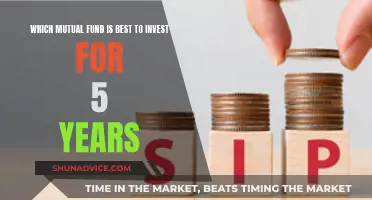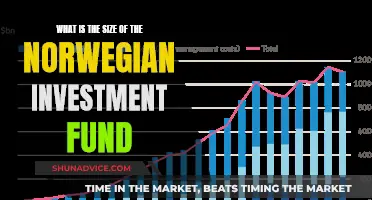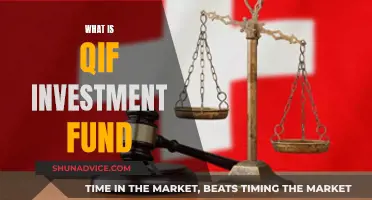
If you're looking to invest funds that you'll need in five years, it's important to consider your risk tolerance and investment goals. While investing in the stock market can offer higher returns, it's generally considered a long-term strategy due to its volatility. For shorter-term goals, low-risk investments such as high-yield savings accounts, money market accounts, and certificates of deposit (CDs) are often recommended. These options provide liquidity and modest returns while protecting your principal. However, with interest rates expected to fall, locking your money into long-term CDs may not be ideal. Government and corporate bonds, dividend stock funds, and value stock funds are also worth considering for short-term investments, but they come with varying levels of risk. It's crucial to assess your financial situation, goals, and risk tolerance before deciding where to invest your funds.
What You'll Learn

High-yield savings accounts
Pros and cons of high-yield savings accounts
Pros:
- Earns higher rates than other savings accounts
- Is a deposit account, so it has federal insurance (unlike investments)
- Can usually be opened online
Cons:
- May require a higher minimum opening balance compared to regular savings accounts
- Online-only accounts mean face-to-face customer service is often not an option
How to choose a high-yield savings account
When choosing a high-yield savings account, it's important to look beyond the interest rate and consider the following:
- Monthly fees
- Minimum balance requirements
- Withdrawal limits
- Whether the account meets your overall banking needs
Examples of high-yield savings accounts
- UFB Portfolio Savings: No monthly fee, no minimum deposit or balance requirement, free ATM card with unlimited withdrawals
- Synchrony Bank High Yield Savings: No monthly fee or minimum deposit, unlimited transactions at an ATM, up to six free withdrawals or transfers per statement cycle
- Marcus by Goldman Sachs High-Yield Online Savings: No fees, no minimum deposit requirement, easy mobile access
- CIT Bank Platinum Savings: 5% APY on balances of $5,000 or more, no monthly service fees, $100 minimum deposit
- SoFi Checking and Savings: 4.3% APY with direct deposit, no monthly fee, no minimum balance or deposit needed
Currency Funds: Diversify Your Portfolio and Gain Globally
You may want to see also

Short-term bond funds
Investors in short-term bond funds earn a yield, which measures the income produced by the bonds in the portfolio relative to the current market price. Short-term bond funds can be a good place to invest money that you may need in the next few years. They are not risk-free, but they are safer than investing in high-yield bonds or the stock market.
- SPDR Portfolio Short-Term Corporate Bond ETF (SPSB): Tracks the performance of the Bloomberg U.S. 1-3 Year Corporate Bond Index. Offers exposure to U.S. corporate bonds with maturities between one and three years.
- IShares 1-5 Year Investment Grade Corporate Bond ETF (IGSB): Tracks the performance of an investment-grade corporate bond index with maturities between one and five years. Holdings include bonds issued by Bank of America, JPMorgan Chase, and Microsoft.
- Schwab 1-5 Year Corporate Bond ETF (SCHJ): Tracks the total return of an index measuring the performance of the short-term U.S. corporate bond market. Holds corporate bonds with remaining maturities between one and five years.
- Vanguard Short-Term Bond ETF (BSV): Tracks the performance of a market-weighted bond index made up of investment-grade bonds with a dollar-weighted average maturity of 1-5 years. Holds government bonds, high-quality corporate bonds, and investment-grade international dollar-denominated bonds.
- Fidelity Short-Term Bond Fund (FSHBX): Aims to produce a high level of current income while preserving capital. Typically invests at least 80% of its assets in all types of investment-grade debt and maintains a dollar-weighted average maturity of three years or less.
Mutual Funds in India: Best Time to Invest
You may want to see also

Bank certificates of deposit
CDs generally offer higher interest rates than savings accounts, but there is a trade-off: you lose withdrawal flexibility. If you withdraw your funds before the maturity date, you will be charged an early withdrawal penalty. The penalty will depend on the length of the CD term and the specific policies of the bank or credit union. In some cases, the penalty may eat into your principal, so it's important to carefully review the terms and conditions before opening a CD.
When deciding whether to open a CD, it's important to consider your financial goals and time frame. CDs are a good option if you have cash that you don't need immediate access to but will want within a few years. They are also a good choice if you want a conservative investment with lower risk and volatility than stocks and bonds. However, keep in mind that tying up your money in a long-term CD may mean missing out on higher interest returns if the federal funds rate increases during the term of your CD.
To get the best rate on your CD, it's important to shop around and compare rates from different banks and credit unions. The interest rate you earn will depend on the length of the term, with longer terms generally offering higher rates. Additionally, some institutions may offer promotional rates or specialty CDs, such as bump-up CDs or no-penalty CDs. When choosing a CD, it's also important to consider the economic environment and whether interest rates are expected to rise. If rates are expected to increase, a variable-rate CD or a bump-up CD may be a good option.
Overall, CDs are a safe and conservative investment option for those looking to boost their savings with a fixed interest rate. They are particularly suitable for those who want to save for a specific goal, such as a vacation, a new home, or a car, without taking on the risk associated with stocks and bonds.
Vanguard Funds: Exploring India-Centric Investment Opportunities
You may want to see also

Dividend stock funds
There are two main ways to invest in dividend stocks: through funds such as index funds or exchange-traded funds (ETFs), or by purchasing individual dividend stocks.
Investing in Dividend Stock Funds
Dividend ETFs or index funds offer instant diversification by allowing investors to access a selection of dividend stocks within a single investment. This means that with just one transaction, you can own a portfolio of dividend stocks. The fund will then pay you dividends at regular intervals, which you can take as income or reinvest.
Investing in Individual Dividend Stocks
Building a portfolio of individual dividend stocks requires more time and effort, but it offers investors the ability to build a custom portfolio that may provide a higher yield than a dividend fund. It also allows for lower expenses, as ETFs and index funds charge an annual fee called an expense ratio. Here are the steps to investing in individual dividend stocks:
- Find a dividend-paying stock: You can search for stocks that pay dividends on financial websites or your online broker's website. Free stock screeners can also be used for this purpose.
- Evaluate the stock: Compare the dividend yields of the stock with those of its peers. A company with a significantly higher dividend yield than its competitors may be a sign of trouble rather than an opportunity. Also, look at the stock's payout ratio, which indicates how much of the company's income is going towards dividends. Generally, a payout ratio above 80% means the company is putting a large percentage of its income into dividend payments.
- Decide how much stock to buy: If you're buying individual stocks, you'll need diversification. For example, if you're buying five stocks, you could put 2% of your portfolio in each. However, if a stock is riskier, you might want to buy less of it and allocate more of your money to safer choices.
It's important to remember that dividends are never guaranteed, and companies can change or eliminate them at will. When investing in dividend stocks, whether through funds or individual stocks, it's crucial to focus on the company's ability to consistently increase its dividend rather than solely on its current dividend yield.
Luxembourg Funds: Why Investors Should Consider This Option
You may want to see also

Value stock funds
Value investing was developed by Columbia Business School professors Benjamin Graham and David Dodd in 1934 and was later popularised by Graham in his 1949 book, "The Intelligent Investor". The strategy is based on the belief that the market overreacts to news and that stock price movements don't always align with a company's long-term fundamentals. Value investors actively seek out these undervalued stocks, which may be overlooked or underappreciated by the market.
When identifying potential investments, value investors use various financial metrics and analysis techniques. They look at a company's financial performance, revenue, earnings, cash flow, profit, brand, business model, target market, and competitive advantage. Some common metrics used include price-to-book (P/B) and price-to-earnings (P/E) ratios, as well as free cash flow.
Some examples of value funds include the Vanguard Equity-Income Fund Investor Shares (VEIPX), the ClearBridge Large Cap Value Fund (SAIFX), and the Invesco S&P 500 Enhanced Value ETF (SPVU). These funds typically have a long-term investment horizon and are suitable for investors seeking a more stable, steady growth of their investments.
Money Market Funds: When to Invest for Maximum Returns
You may want to see also
Frequently asked questions
Some safe investment options for money you need in less than 5 years include:
- Online savings accounts – These accounts are easily accessible and offer higher yields than standard savings accounts.
- Money market accounts – These accounts are FDIC-insured and currently offer annual percentage yields between 4% and 5%.
- Certificates of Deposit (CDs) – CDs are considered low-risk and offer a higher interest rate than savings accounts. They are commonly offered in 5-year terms.
- Treasury bills – These are short-term investments backed by the US government and mature in a few days to a year.
- Municipal bonds – These bonds are issued by state and local governments and often have short-term maturity periods. They are generally tax-exempt but offer lower yields.
Some riskier investment options include:
- Stocks – While stocks have the potential for high returns over the long term, they are volatile and may not be suitable for short-term investments.
- Corporate bonds – These bonds are taxed but offer higher yields, making them suitable for lower-income investors.
- High-yield bonds – These bonds offer greater payouts but have lower credit ratings and higher risk.
- Cryptocurrency – Cryptocurrency is a volatile market and considered a risky investment, but it has the potential for high returns.
When investing for the short term, it is important to consider your risk tolerance, time horizon, financial situation, and investment goals. It is also crucial to understand the risks and returns associated with different investment options and ensure that your investments are calibrated to your time horizon. Additionally, diversifying your investments can help reduce risk.







